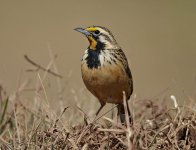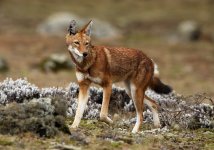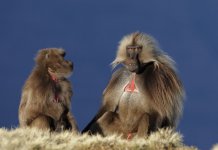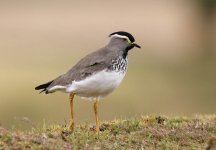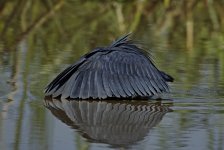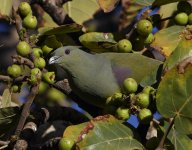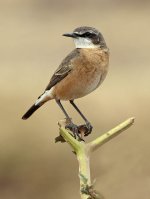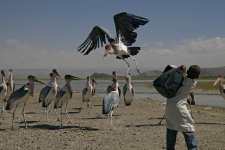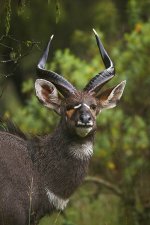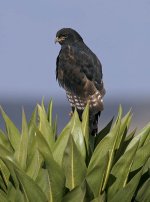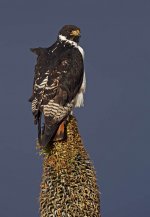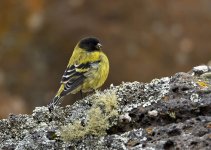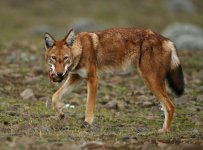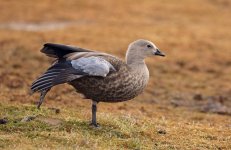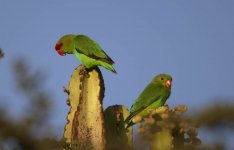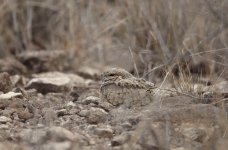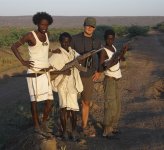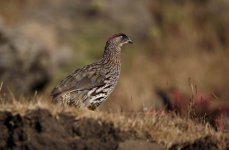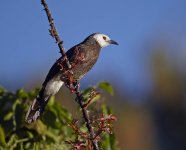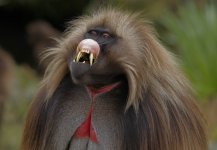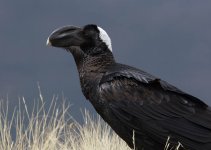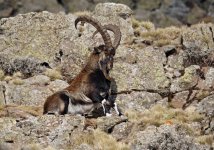Ignacio
Well-known member
With apologies for the delay in posting it, this is a report of a 3-week private tour to Ethiopia I took from November 23 to December 17, 2009. Although I wanted to see and photograph as many of the Abyssinian endemics as possible, I also wanted to spend a significant amount of time in mountain areas that would increase my chances of decent photos of Ethiopian Wolf, Gelada and Walia Ibex. In order to do this I had to sacrifice time searching for some endemics, like Sidamo Lark and some of the seedeaters (although we did find Salvadori's Serin in an unexpected location, see below).
The itinerary was designed with Rockjumper Birding Tours, a company I've worked with on several trips. I knew my guide Markus Lilje from a previous trip to Namibia and was confident of his abilities, even though this was his first time in Ethiopia; we also had two excellent local drivers with good knowledge of birds and sites.
Ethiopia is unique among African countries in almost every possible aspect. Its birdlife stands out for its wealth of endemic species: 32, if we include Eritrea and consider the whole Abyssinian region, without the absurd partition that deprives Ethiopia of access to the sea. It is also the one place in the world to see such rare and extraordinary mammals as Ethiopian Wolf, Gelada and Walia Ibex, and being nowadays the only safe and accessible destination in the Horn of Africa, it offers the opportunity to see many other species restricted to this region, closed to travelers until quite recently.
People are also different from other African countries. Abyssinia has a Christian tradition that dates practically from the times of the Apostles, and most people profess the Orthodox Christian faith, in its unique Ethiopian tradition. Churches and rites are unlike any other in the Christian world.
From what I saw, Ethiopians tend to keep to themselves and don’t show much interest in foreign visitors. In a few places children would try to sell their small handicrafts, but other than that we were rarely approached. They are also not the most cheerful people I have met in Africa. Especially in the south, it can be very difficult to photograph people in Ethiopia (at least, interesting-looking people); women would often their faces when seeing a camera, and most of my enquiries for permission would be met with a negative. In rural areas throughout the country, men often carry firearms, the AK47 being a favorite, and in the Afar region it was mandatory to carry armed protection with us. However, we never experienced any trouble and at no time did we have the slightest feel of danger.
Traveling in Ethiopia is relatively straightforward, but a 4x4 vehicle is highly advisable, as well as a driver who knows his way around. The roads around Addis Ababa are excellent, but as one gets away from main cities they often become difficult, especially after rain. We never found military or police checkpoints and were never stopped by the police; the only time when we were close to having a problem was with the authorities in the Simien Mountains National Park. Professional photographers are required to pay an extra fee to work in the park, and the equipment (I was carrying a very conspicuous 800mm lens with a heavy tripod) prompted park rangers to stop us on three occasions. I tried to stay away from the arguments, but according to our very capable guide and translator, we got close to being fined; he mentioned the photographer’s fee to be 3,000 US$!
Comfortable accommodation is available almost everywhere we went, and food is usually good. Ethiopian traditional cuisine is delicious if one is a little adventurous; most tourist hotels assume that foreign visitors won’t even try it, and instead offer a bland version of Western food, but traditional dishes are often available if asked for. The one exception regarding both accommodation and food was the infamous Green Hotel in Yabello, which has become something of a joke among travelers, but even this wasn’t really too bad.
Books.
The one field guide to the region is Birds of the Horn of Africa, by Redman, Stevenson and Fanshawe, published by Helm. It came out shortly before my trip, and I was a little disappointed to find that it’s just a version of Helm’s previous Birds of East Africa, with the addition of the region’s endemics. However, it is a good and useful book in the format of text and map facing the plates.
Also from Helm, Birds of Ethiopia and Eritrea by John Ash and John Atkins is an excellent atlas covering in detail the distribution and status of every species recorded in the two countries. The introduction and the chapter on the history of ornithology in the region are especially interesting.
Birding Ethiopia by Behrens, Barnes and Boix, published by Lynx, is a guide to the country’s birding sites, nicely illustrated with good photos. Although I couldn’t test it in the field (it was released after my trip) it’s very well written and the descriptions and directions are accurate and easy to follow.
A new book is expected to be released at the British Birdfair this month (August 2010): Where to watch birds in Ethiopia, by Claire Spottiswoode et al, published by Helm.
As usual, the Kingdon Field Guide to African Mammals is the reference guide for its subject, although the more I use this book, the less I like it. Although the species descriptions are thorough and readable, the “mute” distribution maps and the arbitrary use of common and scientific names seem designed to confuse the reader.
Lonely Planet’s Ethiopia and Eritrea is in my opinion the best and most practical travel guide, both in its contents and its size. However, Bradt’s Ethiopia is written in a more personal way by Philip Briggs and can be very entertaining. It also covers more deeply aspects of wildlife and birdlife.
(More to follow. I attach photos of a few endemics; the whole photo collection from the trip can be seen in the new photo section at www.iyufera.com)
The itinerary was designed with Rockjumper Birding Tours, a company I've worked with on several trips. I knew my guide Markus Lilje from a previous trip to Namibia and was confident of his abilities, even though this was his first time in Ethiopia; we also had two excellent local drivers with good knowledge of birds and sites.
Ethiopia is unique among African countries in almost every possible aspect. Its birdlife stands out for its wealth of endemic species: 32, if we include Eritrea and consider the whole Abyssinian region, without the absurd partition that deprives Ethiopia of access to the sea. It is also the one place in the world to see such rare and extraordinary mammals as Ethiopian Wolf, Gelada and Walia Ibex, and being nowadays the only safe and accessible destination in the Horn of Africa, it offers the opportunity to see many other species restricted to this region, closed to travelers until quite recently.
People are also different from other African countries. Abyssinia has a Christian tradition that dates practically from the times of the Apostles, and most people profess the Orthodox Christian faith, in its unique Ethiopian tradition. Churches and rites are unlike any other in the Christian world.
From what I saw, Ethiopians tend to keep to themselves and don’t show much interest in foreign visitors. In a few places children would try to sell their small handicrafts, but other than that we were rarely approached. They are also not the most cheerful people I have met in Africa. Especially in the south, it can be very difficult to photograph people in Ethiopia (at least, interesting-looking people); women would often their faces when seeing a camera, and most of my enquiries for permission would be met with a negative. In rural areas throughout the country, men often carry firearms, the AK47 being a favorite, and in the Afar region it was mandatory to carry armed protection with us. However, we never experienced any trouble and at no time did we have the slightest feel of danger.
Traveling in Ethiopia is relatively straightforward, but a 4x4 vehicle is highly advisable, as well as a driver who knows his way around. The roads around Addis Ababa are excellent, but as one gets away from main cities they often become difficult, especially after rain. We never found military or police checkpoints and were never stopped by the police; the only time when we were close to having a problem was with the authorities in the Simien Mountains National Park. Professional photographers are required to pay an extra fee to work in the park, and the equipment (I was carrying a very conspicuous 800mm lens with a heavy tripod) prompted park rangers to stop us on three occasions. I tried to stay away from the arguments, but according to our very capable guide and translator, we got close to being fined; he mentioned the photographer’s fee to be 3,000 US$!
Comfortable accommodation is available almost everywhere we went, and food is usually good. Ethiopian traditional cuisine is delicious if one is a little adventurous; most tourist hotels assume that foreign visitors won’t even try it, and instead offer a bland version of Western food, but traditional dishes are often available if asked for. The one exception regarding both accommodation and food was the infamous Green Hotel in Yabello, which has become something of a joke among travelers, but even this wasn’t really too bad.
Books.
The one field guide to the region is Birds of the Horn of Africa, by Redman, Stevenson and Fanshawe, published by Helm. It came out shortly before my trip, and I was a little disappointed to find that it’s just a version of Helm’s previous Birds of East Africa, with the addition of the region’s endemics. However, it is a good and useful book in the format of text and map facing the plates.
Also from Helm, Birds of Ethiopia and Eritrea by John Ash and John Atkins is an excellent atlas covering in detail the distribution and status of every species recorded in the two countries. The introduction and the chapter on the history of ornithology in the region are especially interesting.
Birding Ethiopia by Behrens, Barnes and Boix, published by Lynx, is a guide to the country’s birding sites, nicely illustrated with good photos. Although I couldn’t test it in the field (it was released after my trip) it’s very well written and the descriptions and directions are accurate and easy to follow.
A new book is expected to be released at the British Birdfair this month (August 2010): Where to watch birds in Ethiopia, by Claire Spottiswoode et al, published by Helm.
As usual, the Kingdon Field Guide to African Mammals is the reference guide for its subject, although the more I use this book, the less I like it. Although the species descriptions are thorough and readable, the “mute” distribution maps and the arbitrary use of common and scientific names seem designed to confuse the reader.
Lonely Planet’s Ethiopia and Eritrea is in my opinion the best and most practical travel guide, both in its contents and its size. However, Bradt’s Ethiopia is written in a more personal way by Philip Briggs and can be very entertaining. It also covers more deeply aspects of wildlife and birdlife.
(More to follow. I attach photos of a few endemics; the whole photo collection from the trip can be seen in the new photo section at www.iyufera.com)




